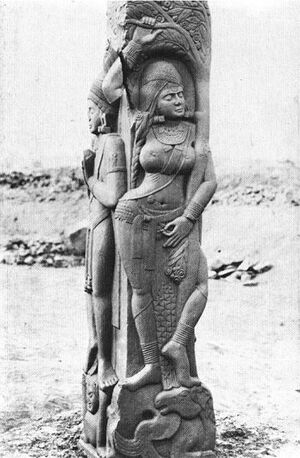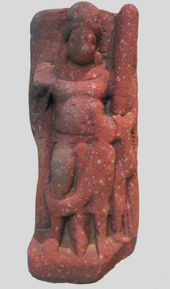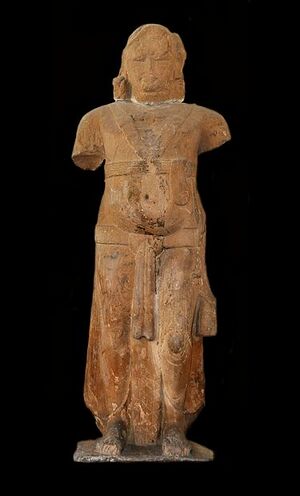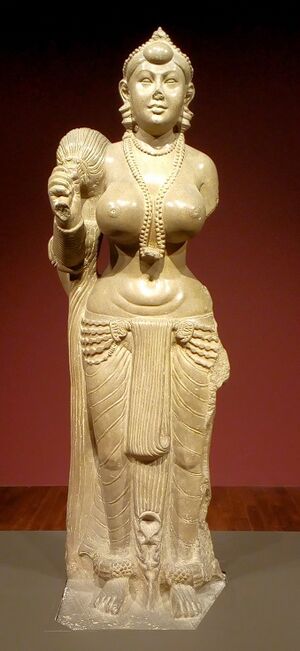Yaksha
| Author:Laxman Burdak, IFS (R) |



Yaksha (यक्ष) is the name of a broad class of nature-spirits, usually benevolent, who are caretakers of the natural treasures hidden in the earth and tree roots.[1] They appear in Hindu mythology, Jain and Buddhist mythology. The feminine form of the word is yakṣī or yakṣiṇī (Pāli: yakkhī or yakkhinī).
Variants
General character
In Hindu, Jain and Buddhist mythology, the Yaksha has a dual personality. On the one hand, a yakṣa may be an inoffensive nature-fairy, associated with woods and mountains; but there is a much darker version of the yakṣa, which is a kind of cannibalistic ogre, ghost or demon that haunts the wilderness and waylays and devours travelers, similar to the rakṣasas.
In Kālidāsa's poem Meghadūta, for instance, the yakṣa narrator is a romantic figure, pining with love for his missing beloved. By contrast, in the didactic Hindu dialogue of the Yakṣapraśnāḥ ("questions of the Yakṣa"), a dangerous cannibalistic Yaksha, the tutelary spirit of a lake, threatens the life of the epic hero Yudhisthira.
The yakṣas may have originally been the tutelary gods of forests and villages, and were later viewed as the steward deities of the earth and the wealth buried beneath.
In Indian art, male yakṣas are portrayed either as fearsome warriors or as portly, stout and dwarf -like. Female yakṣas, known as yakṣiṇīs, are portrayed as beautiful young women with happy round faces and full breasts and hips.
In the state of Kerala, in South India, Yakshis are depicted as vampire enchantresses.
The Kiratas are Limbu, Rai, Yakkha, Sunuwar and Lepcha tribes of Eastern Nepal [2][3]
Yakshas in Mahabharata
The banks of river Narmada is described as the birth place of yaksha king Kubera (Vaisravana), where his father Visravas, who was a sage, lived. It is also a territory of Gandharvas. (Mahabharata: 3,89). Gokarna, Karnataka is also mentioned as a place of yakshas and Pisacha Kingdom, and Kinnara Kingdom and the great Nagas Kingdom, and Siddhas and charanas and gandharvas. (3,85)
Vana Parva, Mahabharata/Book III Chapter 174 tells us Pandvas journey twelfth year of their sojourn in forests having arrived reach Saraswati River..... The holy fig, the rudaraksha, the rohitaka, the cane and the jujube, the catechu, the sirisha, the bel and the inguda and the karira and pilu and sami trees grew on the banks of the Saraswati. Wandering about with contentment in (the vicinity of) the Saraswati which was, as it were, the home of the celestials, and the favourite (resort) of Yakshas and Gandharvas and Maharshis, those sons of kings lived there in happiness."
- 21 ततश च यात्वा मरुधन्व पार्श्वं; सथा धनुर्वेथ रतिप्रधानाः
- सरस्वतीम एत्य निवासकामाः; सरस ततॊ दवैतवनं परतीयुः
- 22 समीक्ष्य तान थैतवने निविष्टान; निवासिनस तत्र ततॊ ऽभिजग्मुः
- तपॊ थमाचार समाधियुक्तास; तृणॊथ पात्राहरणाश्म कुट्टाः
- 23 पलक्षाक्ष रौहीतक वेतसाश च; सनुहा बथर्यः खथिराः शिरीषाः
- बिल्वेङ्गुथाः पीलु शमी करीराः; सरस्वती तीररुहा बभूवुः
- 24 तां यक्षगन्धर्वमहर्षिकान्ताम; आयाग भूताम इव थेवतानाम
- सरस्वतीं परीतियुताश चरन्तः; सुखं विजह्रुर नरथेव पुत्राः
Yakṣas in Buddhism
In Buddhist countries yakṣas are known under the following names: Chinese language Pinyin: 夜叉 yè chā, Japanese language: nihongo|Yasha|夜叉, Burmese language: ba-lu).
In Buddhist mythology, the yakṣa are the attendants of Vaiśravaṇa, the Guardian of the Northern Quarter, a beneficent god who protects the righteous. The term also refers to the twelve heavenly generals who guard the Buddha of Medicine (Sanskrit: Bhaiṣajya; Tibetan language: sangs-rgyas sman-bla; Chinese and Japanese: 藥師如來, 薬師如来)
In Mahavansa
Mahavansa/Chapter 10 writes ...Ten years after his consecration did Pandukabhaya the over the whole of the island of Lanka . With Kalavela and Cittaraja, who were visible (in bodily form) the prince enjoyed his good fortune, he who had Yakkhas and Bhutas for friends. Between the king Pandukabhaya and Abhaya were seventeen years without a king.
Yakshas in Jats
The prakrit form of the sanskrit word Yaksha is Jakh. Some of the jat clans having possible linkages with the Yakshas are Jakhar, Jakha, Jakhaudia.
- Jakhar - The Jat historian Hukum Singh Panwar (Pauria)[4] writes that Jakhar is derived from Yaksha. This tribe Jakhar claim Jakha or Jakhu, known as Yaksha or Yakshu in Sanskrit, to be their most ancient eponymous progenitor. [5][6] Hukum Singh Panwar further writes that Yakshas were one of the tribes who fought the last battle of Dasrajna War (the battle of ten kings) under the leadership of Dasa Raja named Bheda against Bharatas tribes on the banks of Yamuna. The other tribes were Ajas, Sigrus, Alinas, Pakthas, Bhalana, Sivas, and Visanin. [7] [8] M.L. Bhargava writes that after the defeat on the Yamuna River they migrated to the Oxus (Geek name) valley and gave the name to valley as Jaksha or Jaaksha. He opines that Budakhsis and their city Badakshan are known after the combined name of Bheda, the leader of the Yakshas and that of the latter, Bheda is also a Jat clan. [9][10]
- Jakhaudiya (जाखौदिया) Jakhaudia (जाखौदिया) gotra of Jats are found around Delhi. This gotra originated from place name Jakhaud (जाखौद). This village was founded by one of seven sons of Maharaja Anangpal.[11]
Yaksha in Jainism
23rd Jain tirthankar Parshvanath is always represented with the hood of a snake shading his head. The Yaksha Dharanendra and the Yakshi Padmavati are often shown flanking him.
Yaksha Kingdom
Yaksha Kingdom refers to the territory of a tribe called Yakshas who were one among the Exotic Tribes of Ancient India. They had kinship with another similar tribe viz. Rakshasas. Yaksha king Vaisravana (also known as Kubera, Kuvera etc) and Rakshasa king Ravana were both sons of the sage Visrava Paulastya. Kubera is sometimes mentioned as a Rakshasa king. Kubera ruled a Yaksha kingdom of enormous wealth near the Kailasa mountains. Pandavas visited this place during their forest life, by mounting the Himalayas with the help of Rakshasa Ghatotkacha and his friends.
Didarganj Yakshi

The Didarganj Yakshi (or Didarganj Chauri Bearer; Hindi: दीदारगंज यक्षी) is sometimes considered as one of the finest examples of Mauryan art in the 3rd century BCE.[12] Alternatively, it is rather dated to the 2nd century CE, based on the analysis of shape and ornamentation.[13][14][15] The treatment of the forelock in particular is said to be characteristically Kushan.[16]
The sculpture is currently located in the Bihar Museum in Bihar, India.[17] It is 64" tall, carved out of a single piece of stone.[18] This life-size standing image is tall, well-proportioned, free-standing sculpture is made of sandstone with well polished surface, a characteristic usually associated with Mauryan polish. The Flywhisk (chauri) is held in the right hand whereas the left hand is broken. The lower garment create a somewhat transparent effect. The Didarganj Yakshi is estimated to date from ca. 3rd century BCE to the 2nd century CE.[19][20] It was excavated on the banks of the Ganges River, at the hamlet of Didarganj Kadam Rasual, northeast of the Qadam-i-Rasul Mosque in Patna City, on October 18, 1917 by the villagers and by the noted archaeologist and historian, Professor J N Samaddar[21] Professor Samaddar, with the help of the then president of Patna Museum Committee and member of Board of Revenue, Mr. E. H. C. Walsh and Dr. D. B. Spooner, the noted archaeologist, retrieved the figure in Patna Museum, Patna.
मंदराचल
विजयेन्द्र कुमार माथुर[22] ने लेख किया है ...मंदराचल (AS, p.688): 'श्वेतं गिरिं प्रवेक्ष्यामो मंदरं चैव पर्वतं, यत्र मणिवरौ यक्ष: कुबेरश्चैव यक्षराट्'-- महाभारत 139,5. इस उद्धरण में मंदराचल का पांडवों की उत्तराखंड की यात्रा के संबंध में उल्लेख है जिससे यह पर्वत हिमालय में बद्रीनाथ या कैलाश के निकट कोई गिरि-श्रंग जान पड़ता है. विष्णु पुराण 2.2.16 के अनुसार मंदर पर्वत इलावृत के पूर्व में है-- 'पूर्वेण मंदरोनाम दक्षिणे गंधमादन:' मंदराचल का पुराणों में क्षीरसागर-मंथन की कथा में भी वर्णन है. इस आख्यायिका के अनुसार सागर-मंथन के समय देवताओं और दानवों ने मंदराचल को मथनी बनाया था.
वरण
Varana वरण (AS, p.833) - बुद्धचरित 21,25 में वर्णित एक नगर जहाँ वारण नामक यक्ष को बुद्ध ने धर्म दीक्षा दी थी. इसका अभिज्ञान अनिश्चित है. (दे. वरन)[23]
इतिहास
विजयेन्द्र कुमार माथुर[24]ने लिखा है .... हाटक (AS, p.1018): महाभारत सभापर्व में उल्लिखित स्थान है, जिसे यक्षों का देश कहा गया है. इस पर उत्तर दिशा की दिग्विजय के प्रसंग में अर्जुन ने विजय प्राप्त की थी- यह स्थान कालिदास के मेघदूत की अलका के निकट ही स्थित होगा. मानसरोवर यहां से समीप ही था- यह तिब्बत में स्थित वर्तमान मानसरोवर और कैलाश का निकटवर्ती प्रदेश था. यहां गुहयकों (यक्षों) तथा गंधर्वों की बस्ती था. श्री बी.सी. ला के मत में हाटक वर्तमान अटक (पाकिस्तान) है. एन.ल. डे के अनुसार यह हूण देश का नाम है.
दीदारगंज यक्षिणी
विजयेन्द्र कुमार माथुर[25] ने लेख किया है ...दीदारगंज (AS, p.438) एक ऐतिहासिक स्थान जो बिहार प्रांत की राजधानी पटना के पास स्थित है। दीदारगंज से 1917 में एक यक्षिणी की सुन्दर मूर्ति प्राप्त हुई। वह मूर्ति अपने हाथ में चमर धारण की हुई है। अतः इसे चामरग्राही यक्षिणी कहा गया है। विद्वानों के मत में यह मूर्ति मौर्यकालीन है। मूर्ति की रचना बहुत ही सुन्दर तथा इसकी मुद्रा अतीव स्वाभाविक है। मूर्ति में शरीर के अंग-प्रत्यंग का अंकन अत्यंत सजीवता के साथ किया गया है। मूर्ति का ऊपरी भाग वस्त्र रहित है तथा अधो भाग में वह साड़ी पहने है। मूर्ति का एक हाथ खंडित है तथा दूसरे में चमर धारण किए हुए है। मूर्ति गले में मुक्तामाल शोभायमान है, जो पुष्ट वक्ष के ऊपर लहराती हुई लटक रही है। क्षीण कटि तथा स्थूल नितम्बों की गुरुता का अंकन भी विदग्धतापूर्ण है। सम्प्रति यह मूर्ति पटना के संग्रहालय में सुरक्षित है।
References in Mahabharata
Yaksha Territory
The territory of Yakshas under Kubera is mentioned as the region surrounding the Kailasa mountains and Lake Manasarovar lake (Tibet) in the Himalayas.
Pandavas Expeditions
Expeditions of Pandavas (3:139) guided by sage Lomasa:-
Lomasa said, now hast thou left behind the mountains Usiravija, Mainaka and Sweta, as well as the Kala hills, O son of Kunti, O bull among the descendants of Bharata, here flow before thee the seven Gangas. This spot is pure and holy. Here Agni blazeth forth without intermission. Now wilt thou see the play-ground of the Devas, marked with their footprints, as we have passed the mountain Kala. We shall now ascend that white rock—the mountain Mandara, inhabited by the Yakshas, Manibhadra and Kuvera, king of the Yakshas. O king, at this place eighty thousand fleet Gandharvas, and four times as many Kimpurushas and Yakshas of various shapes and forms, holding various weapons, attend upon Manibhadra, king of the Yakshas. In these regions their power is very great. And in speed they are even as the wind. They can, without doubt, displace even the lord of the Devas from his seat. Protected by them, and also watched over by the Rakshasas, these mountains have been rendered inaccessible. Here are fierce ministers of Kuvera and his Rakshasa kindred.
Section 3:152 describes Pandava Bhima's expedition to this territory:-
Bhima saw in the vicinity of the Kailasa cliff, that beautiful lotus lake surrounded by lovely woods, and guarded by the Rakshasas. And it sprang from the cascades contiguous to the abode of Kuvera. And situated on the rocky elevation this expanse of excellent water was exceedingly fair. That unearthly receptacle of waters was covered with celestial Saugandhika lotuses. And this lake was the sporting region of the high-souled Kuvera, the king of the Yakshas. And it was held in high regard by the Gandharvas the Apsaras and the celestials. And it was frequented by the celestial sages and the Yakshas and the Kimpurushas and the Rakshasas and the Kinnaras; Hundreds and thousands of Rakshasas, named Krodhavasas, were guarding that lake, wearing uniforms and armed with various weapons.
Ashtavakra's expeditions
Section 13:19 describes sage Ashtavakra's expedition to this territory:-
The illustrious Ashtavakra set out on his journey. He proceeded more and more towards the north and at last reached the Himavat mountains peopled by Siddhas and Charanas Arrived at the Himavat mountains, that foremost of Brahamanas then came upon the sacred river Vahuda whose waters produce great merit. He rested for some more time by the side of that lake in the course of the Vahuda whose shores he had reached. Refreshed by such rest, he set out from that region and then proceeded towards Kailasa. He then beheld a gate of gold. He saw also the Mandakini and the Nalini of the high-souled Kubera, the Lord of Treasures. Beholding the Rishi arrived there, all the Rakshasas having Manibhadra for their head, who were engaged in protecting that lake abounding with beautiful lotuses, came out in a body for welcoming and honouring the illustrious traveller.
More information on the region
Section 5:111:-
Because all the treasures of the north stretches in a line towards the east and the west, therefore is the north sometimes called the central region. Hither, is the asylum, known by the name of Vadari Badrinath. It was here, on the breast of Kailasa, that Kubera, was installed on the sovereignty of the Rakshasas, the Yakshas, and the Gandharvas. It is in this region that (Kuvera’s gardens called) Chitraratha lie, and it is here that the asylum of (the Munis called the) Vaikhanasas is situate. It is here, that the celestial stream called Mandakini, and the mountain Mandara are to be seen. It is here that the gardens called Saugandhi-kanaka are always guarded by the Rakshasas. Here are many plains covered with grassy verdure, as also the plantain forest, and those celestial trees called the Sautanakas. It is in this region that the mountains of Kailasa lie, the abode of Ailavila (Kuvera). It is here that the ten Apsaras known by the name of Vidyutprabha had their origin. Here, in this quarter, at a place called Usiravija, by the side of the golden lake, king Marutta performed, a sacrifice. It is here that the brilliant and shining gold mines of Himavat exhibit themselves to the illustrious and regenerate Rishi Jimuta and hence known by the name of the Jaimuta gold. At (14:16) Pandavas were mentioned as mining this gold.
The region, called Mandakini, of king Vaisravana is attained by those highly blessed persons for whom are every joy and comfort. There Gandharvas and Yakshas and Apsaras live (13:102).
The spot where Ganga rusheth past, cleaving the foremost of mountains which is frequented by Gandharvas and Yakshas and Rakshasas and Apsaras, and inhabited by hunters, and Kinnaras, is called Gangadwara (3:90).
Delicious and cooling breezes murmuring through forests of tall Mandaras, and bearing fragrance of extensive plantations of jasmine, as also of the lotuses on the bosom of the river Alaka and of the Nandana-gardens, always minister to the pleasure of the King of the Yakshas. (2,10).
On the south of Nishadha is the Varsha called Hiranmaya where is the river called Hiranwati. There, liveth that foremost of birds named Garuda. And the people there, are all followers of the Yakshas, wealthy, and of handsome features (6:8).
- Brahma-vodhya, and Vrihadvati were mentioned as rivers of Yaksha regions (6:9).
- Arjuna had encountered Yakshas in Khandava forests.
- Karna had encountered Yakshas in Mahendra mountains.
- Yakshas were mentioned to be dwelling on the northern banks of river Saraswati (9:37).
King Vaisravana (Kubera)
The banks of river Narmada is described as the birth place of Yaksha king Kuvera (Vaisravana), where his father Visravas, who was a sage, lived (MBh 3,89). King Vaisravana or Kubera was the ruler of Lanka Kingdom which was guarded by hosts of Rakshasas. He had a chariot called Pushpaka capable of going everywhere according to the will of the rider. And the kingship of the Yakshas and the sovereignty over sovereigns were also his (2,272). Rakshasa Ravana defeated Kuvera in battle and obtained from him the sovereignty of Lanka. That adorable Being, leaving Lanka and followed by Gandharva Kingdom, Yakshas, Rakshasas, and Kinnara Kingdom, went to live on mount Gandhamadana (near Kailasa, Tibet). And Ravana forcibly took from him the celestial chariot Pushpaka.
The lord Kuvera of body resembling pure gold, seated on his car of great splendour, and accompanied by numerous Yakshas came there. And the lord of treasures, possessed of great beauty, came there to see Arjuna, illuminating the firmament with his effulgence. (3:41).
At (3:160) is mentioned an encounter between Pandava Bhima and the Yaksha army. Here Krodhovasa Rakshasas were mentioned as part of Kubera's army. Maniman is mentioned as a friend of Kubera and a leader of the army. Kubera came to see Bhima the destroyer of his army.
- Kubera is sometimes mentioned as Ailavila (5:139).
- Kubera had a son named Nalakubera (9:47).
Sthunakarna
Another prominent Yaksha found mention in Mahabharata is Sthunakarna. He dwelt in a forest close to the Panchala Kingdom. He converted Shikhandini, the daughter of Panchala king Drupada into a male by exchanging his male sexuality with her. Here the Yaksha is addressed as a Guhyaka, the one who dwells in caves or in hidden places.
There was a dense and solitary forest that was the haunt of a very formidable Yaksha called Sthunakarna. From fear of that Yaksha men never went into that forest. And within it stood a mansion with high walls and a gateway, plastered over with powdered earth, and rich with smoke bearing the fragrance of fried paddy. Entering that mansion, Sikhandini, the daughter of Drupada, began to reduce herself by foregoing all food for many days. Thereupon, the Yaksha named Sthuna, who was endued with kindness, showed himself unto her (5,194).
Mystification of Yakshas
At (3:310) of Mahabharata is a conversation of a Yaksha and Pandava king Yudhisthira. Here Yaksha is described as an invisible voice from the sky, coming from the top of the trees, in a dense forest.
Manibhadras, and Vaisravana (Kubera), the king of the Yaksha were worshipped by travellers who travel through lonely territories, for protection against dangers. Manibhadra is one of the warrior in the Yaksha army of Kubera. Gandharvas were also part of his army (3:65).
At (3:229) this is more clear:- The man who beholds Devas while sleeping, or in a wakeful state soon turns mad, and the spirit under whose influence these hallucinations take place is called the Deva spirit. When a person beholds his dead ancestors while he is seated at ease, or lying in his bed, he soon loses his reason, and the spirit which causes this illusion of sensible perception, is called the ancestral spirit. The man who shows disrespect to the Siddhas and who is cursed by them in return, soon runs mad and the evil influence by which this is brought about, is called the Siddha spirit. And the spirit by whose influence a man smells sweet odour, and becomes cognisant of various tastes (when there are no odoriferous or tasteful substances about him) and soon becomes tormented, is called the Rakshasa spirit. And the spirit by whose action celestial musicians (Gandharvas) blend their existence into the constitution of a human being, and make him run mad in no time, is called the Gandharva spirit. And that evil spirit by whose influence men are always tormented by Pisachas, is called the Paisacha spirit. When the spirit of Yakshas enters into the system of a human being by some accident, he loses his reason immediately, and such a spirit is called the Yaksha spirit.
It is known that excepting the first forty seconds the grey twilight preceding nightfall hath been appointed for the wandering of the Yakshas, the Gandharvas and the Rakshasas, all of whom are capable of going everywhere at will (1,172).
Other references
- The Yakshas, milking the Earth, got the power of disappearance at will (7,67).
- The royal Kuvera, the chief of the Yakshas and the Rakshasas, is the lord of the treasury of Indra (12:289).
- Rishi Yaksha of great intelligence succeeded in restoring the Niruktas which had disappeared from the surface of the Earth and sunk into nether regions (12:342).
- Mankanaka is mentioned as a Yaksha and one of the gate keepers of Kubera (3:83).
- Manibhadra is mentioned as the king of Yakshas at (3:64).
- At Kusasthali once there was held a conclave of the Devas. And surrounded by grimvisaged Yakshas, numbering 300 maha-padmas, carrying various weapons, Kubera attended that conclave. (3:160).
- The great Yaksha Amogha with his attendants—the Jambhaka Yakshas and other Rakshasas were mentioned as army men of Kartikeya, in his battle with Asura Mahisha (3:230). (Mahisha himself was the son of an Asura in his wife belonging to the Yaksha tribe.)
- Garuda had encounters with the Yakshas viz. Aswakranda of great courage, Rainuka, the bold Krathanaka, Tapana, Uluka, Swasanaka, Nimesha, Praruja, and Pulina.
- Siva is mentioned as the friend of Kubera (12:284).
List of exotic tribes
- Devas (Rudras, Maruts, Vasus, Adityas)
- Asuras (Daityas, Danavas, Kalakeyas)
- Pisachas, Gandharvas, Kimpurushas, Kinnaras, Yakshas
- Rakshasas
- Vanaras
- Nagas, Suparnas
- Bhutas
Notes
- ↑ Yaksha Publisher-Encyclopedia Britannica, 2007-07-15
- ↑ Indian Literature By Sähitya Akademi, 1981
- ↑ P.218 Problems of Ethnicity in the North-East India By Braja Bihārī Kumāra, Concept Publishing Company, 2007 - Ethnic conflict
- ↑ Hukum Singh Panwar(Pauria), The Jats - Their Origin, Antiquity & Migrations, 1993 Publisher - Manthan Publications, Rohtak, Haryana, ISBN 81-85235-22-8, p. 150-151
- ↑ Yoginder Pal Shastri, op. cit., p. 468
- ↑ Amichand Sharma, Jat Varna mimansa, v.s. 1967
- ↑ Hukum Singh Panwar(Pauria), The Jats - Their Origin, Antiquity & Migrations, 1993 Publisher - Manthan Publications, Rohtak, Haryana, ISBN 81-85235-22-8, p. 150-151
- ↑ Buddha Prakash, op. cit., p. 77
- ↑ M.L. Bhargava, Geography of the Rigvedic India, Lucknow, 1964, p. 129
- ↑ Hukum Singh Panwar(Pauria), The Jats - Their Origin, Antiquity & Migrations, 1993 Publisher - Manthan Publications, Rohtak, Haryana, ISBN 81-85235-22-8, p. 150-151
- ↑ Dr Mahendra Singh Arya, Dharmpal Singh Dudee, Kishan Singh Faujdar & Vijendra Singh Narwar: Ādhunik Jat Itihasa (The modern history of Jats), Agra 1998, Section X, p. 20
- ↑ Chaudhary, Pranava K (28 September 2006). "A fortress chockfull of chinks". Indiatimes.
- ↑ "A History of Ancient and Early Medieval India: From the Stone Age to the 12th Century" by Upinder Singh, Pearson Education India, 2008,p.364
- ↑ ""Ayodhya, Archaeology After Demolition: A Critique of the "new" and "fresh" Discoveries", by Dhaneshwar Mandal, Orient Blackswan, 2003, p.46
- ↑ "A Companion to Asian Art and Architecture" by Deborah S. Hutton, John Wiley & Sons, 2015, p.435
- ↑ "A Companion to Asian Art and Architecture" by Deborah S. Hutton, John Wiley & Sons, 2015, p.435
- ↑ "This museum in Bihar houses a 2300-year-old sculpture carved out of a single stone".
- ↑ Bengal Archeology website, "Didarganj Yakshi" (7 March 2009)
- ↑ Huntington, John C. and Susan L., The Huntington Archive - Ohio State University
- ↑ "A History of Ancient and Early Medieval India: From the Stone Age to the 12th Century" by Upinder Singh, Pearson Education India, 2008
- ↑ Davis, Richard H. (1997). Lives of Indian Images. New Jersey: Princeton University Press.
- ↑ Aitihasik Sthanavali by Vijayendra Kumar Mathur, p.688
- ↑ Aitihasik Sthanavali by Vijayendra Kumar Mathur, p.833
- ↑ Aitihasik Sthanavali by Vijayendra Kumar Mathur, p.1018
- ↑ Aitihasik Sthanavali by Vijayendra Kumar Mathur, p.438
References
- Dictionary of Hindu Lore and Legend (ISBN 0-500-51088-1) by Anna Dhallapiccola
- Encyclopaedia Britannica: Yaksha, EBC: Yaksha
Back to The Ancient Jats

